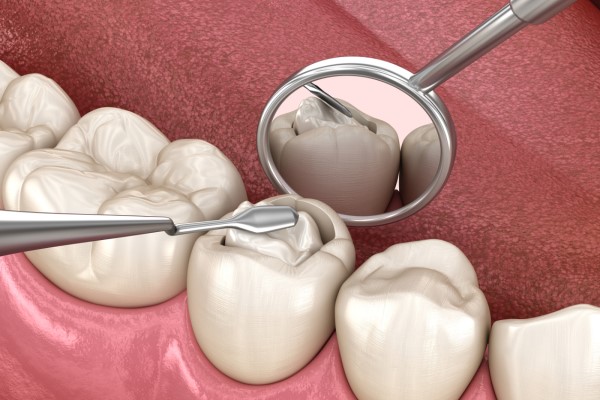How Does a Dental Filling Work?

A cavity indicates that your tooth is decayed to some extent and requires a dental filling. This tooth decay will spread even further if it is not addressed by a dental professional. Cavities are treated by filling them with one of the dental materials designed to treat cavities, which prevents further tooth deterioration. Maintaining the health of your teeth and gums is important since a problem with your mouth may quickly affect your whole body's health.
What are dental fillings and how do they work?
Innovations in the oral health profession have made filling a cavity simpler than ever. Another interesting part is that dental patients now have a say in the sort of dental materials used in their fillings.
Patients should plan to spend around an hour at the dentist's office. This provides the dentist adequate time to do the dental treatment, take any necessary x-rays, and explain every detail of the procedure. The dental professional will numb the teeth, gums, and surrounding skin before the dental filling procedure to keep the patient comfortable and minimize pain. The dentist will prepare the tooth by cleaning out the decay to avoid future damage. After that, the area is thoroughly cleaned before the preferred filling material is applied. It simply takes a few minutes to complete this procedure. After the procedure is over, the mouth will likely be numb for a few more hours. The following are some of the most popular filling materials used today.
Composite fillings
Since composite fillings are custom-made to blend in with the rest of the patient's tooth, they are also known in general dentistry as tooth-colored fillings. This filling material is often chosen by dental patients who do not want their dental restoration to stand out, resulting in a more attractive smile.
Gold fillings
Gold fillings are very robust and long-lasting, with a lifespan of up to 15 years. Due to the conspicuous appearance of gold fillings, dental patients who choose this option are often trying to add some flair to their smile.
Silver fillings
A combination of metals, such as silver, mercury, tin, or copper, are used to make silver fillings, commonly known as amalgam fillings. They are powerful and long-lasting, ranging between 10 and 15 years on average. Silver fillings should be avoided by those who are allergic to metals since there are alternative filling options to choose from.
Aftercare for cavity filling
After the treatment, there will be some discomfort caused by the dentist's scraping and prodding motion to remove the decay, and by the dissipation of the anesthetic. Patients can manage this with pain meds, but they will need to continue routine oral care at home, including daily brushing, flossing, and mouthwash, and limiting the intake of sweet and sugary meals. If there are problems such as sharp edges, crown cracks, or sensitivity, it is necessary to contact the dentist. Chewing with the teeth after a filling is not recommended since it may pull or shatter the filling and create discomfort because the teeth are still mending. The procedure itself is safe and rarely results in complications. However, keep the dentist's phone number handy if you have any questions or concerns about dental fillings.
When should a cavity filling be replaced?
After a few years, dental fillings may require a replacement or repair. Tooth fillings might degrade with time. The fillings may wear out sooner in patients who grind or clench their teeth. It is important to visit the dentist as soon as possible to have the filling changed after discovering cracks or worn areas on the dental fillings. Chewing on a tooth with a cracked filling may lead to more costly and time-consuming repairs than a simple dental filling. The dentist may recommend a crown over a second cavity filling if more decay develops around an existing filling, whether or not the filling is damaged.
Book an appointment if you need a dental filling
Making the ideal choice for your fillings begins with understanding how they operate and which ones are ideal for you. There is no need to be concerned about the safety of the filling you choose.
It will be simpler to treat your cavity if you schedule a dentist appointment as soon as possible. The last thing you want is for the cavity to deteriorate into something more serious, which might lead to tooth loss. Make an appointment with the dental office to get a dental filling performed by a trained and skilled dentist.
Request an appointment here: https://www.smilebeautification.com or call Precision Smiles. at (201) 204-1355 for an appointment in our Hackensack office.
Check out what others are saying about our dental services on Yelp: Composite Fillings in Hackensack, NJ.
Recent Posts
A dental filling falling out of a tooth may feel like a strange "pop" — or you may feel nothing at all upon dislodging the material from your enamel. Anyone who has lost a filling can attest to the panic of wondering what to do next. You may be surprised to know that while fillings…
When individuals experience cavities and other problems that affect their teeth, dentists use a dental filling to repair and restore them. This helps preserve damaged teeth and prevents their loss. Dental fillings are the most common type of dental work: according to the Centers for Disease Control and Prevention, over 90% of Americans have had…
If you are self-conscious about your smile, it could be time to visit a cosmetic dentist. Cosmetic dentists are dental health professionals whose primary focus is improving the appearance of your overall smile. Cosmetic dentistry may include implants, whitening treatments, fillings, and veneers.Before seeing a new oral health care professional, you may want to have…
A cosmetic dentist has a background in general dentistry but focuses their efforts on procedures outside the realm of routine care, such as on the form of the mouth, including how the teeth and/or gums appear. Although there is a common misconception that cosmetic dentists only care about looks, they do ensure full functionality too.…


